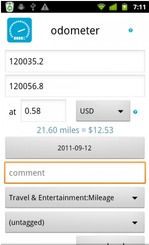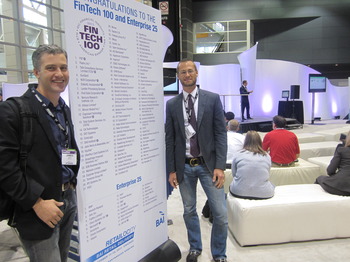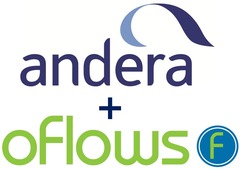 Editor’s note: This guest post was written by Daniel Thomas, a 25-year strategy and product development veteran of the financial services industry. He is a principal consultant with Mindful Insights LLC.
Editor’s note: This guest post was written by Daniel Thomas, a 25-year strategy and product development veteran of the financial services industry. He is a principal consultant with Mindful Insights LLC.
BAI’s annual Retail Delivery was held this year in Chicago during Chicago Ideas Week. So, it only seemed fitting to hit the vendor expo floor with a single question:
“What is your company’s big idea in the financial services retail channel?”
Here are a few of my favorite answers:
Access Softek
 CEO Chris Doner demonstrated a new location-based security feature of their mobile banking platform that he says none of the other mobile banking products have. Others protect against fraud when a mobile phone is lost or stolen by asking the traditional security questions based on what you know (username and password) and what you have (something in your wallet). However, depending on how the user retains these secrets on their phone, they may still be subject to having a bad guy figure it out and transfer money out of their account.
CEO Chris Doner demonstrated a new location-based security feature of their mobile banking platform that he says none of the other mobile banking products have. Others protect against fraud when a mobile phone is lost or stolen by asking the traditional security questions based on what you know (username and password) and what you have (something in your wallet). However, depending on how the user retains these secrets on their phone, they may still be subject to having a bad guy figure it out and transfer money out of their account.
Access Softek adds a third level of security that allows mobile bankers to designate geo-location “safe zones” where they are allowed to log-in to the mobile banking app. But when outside the zone they can not. Doner says that studies show that 98% of the time people log in to their mobile app from just 2 or 3 specific locations. He believes that this feature will increase overall mobile banking usage as it helps overcome security fears holding back adoption.
Chexar
 CEO Drew Edwards believes his company has the long-awaited solution to funding stored-value debit cards or other accounts. It teamed with Cachet Financial Solutions and several other mobile remote deposit capture (RDC) providers to provide guarantee checks deposited using photo deposit services.
CEO Drew Edwards believes his company has the long-awaited solution to funding stored-value debit cards or other accounts. It teamed with Cachet Financial Solutions and several other mobile remote deposit capture (RDC) providers to provide guarantee checks deposited using photo deposit services.
Edwards says Chexar’s guarantee allows the funds from the check to be available to the account holder immediately without fear that the transaction will be reversed should the check bounce. Chexar claims that this will be especially meaningful to the underbanked who pay high fees to cash checks and then pay another fee to load the cash onto a debit card.
Chexar charges 1.5% to 3.5% fees to cover fraud losses and collections. But that’s considerably lower than fees charged by check-cashing companies.
 Clairmail
Clairmail
Chris Craver says their new idea is a service that allows FI customers to configure customized settings that trigger alerts. What’s so new about that? Instead of finding so-called alerts in your email box a day or two later, Clairmail sends real-time text messages which are much more likely to be noticed.
 In a world where FIs are fortifying their systems to defend against fraudulent card use, they neglect one of the most important parties helping them with the battle—the cardholder! Now, users can ask to be alerted when a transaction exceeds their unique limits. And users can make their issuer aware of suspicious purchases so the account can be monitored closely or frozen to reduce subsequent fraudulent charges.
In a world where FIs are fortifying their systems to defend against fraudulent card use, they neglect one of the most important parties helping them with the battle—the cardholder! Now, users can ask to be alerted when a transaction exceeds their unique limits. And users can make their issuer aware of suspicious purchases so the account can be monitored closely or frozen to reduce subsequent fraudulent charges.
Editor’s note: Love the cumulative transaction count on the Clairmail homepage (see inset).
Deluxe
 Not every good idea has to be about online or mobile. Good old customer service goes a long way in maintaining a loyal relationship. Russ Belland at Deluxe Corporation explained that their new SwitchAgent is a high-touch service that FIs can offer new customers to solve one a big pain point when changing banks: Moving recurring debits/credits to the new account without incurring NSF fees in the old account.
Not every good idea has to be about online or mobile. Good old customer service goes a long way in maintaining a loyal relationship. Russ Belland at Deluxe Corporation explained that their new SwitchAgent is a high-touch service that FIs can offer new customers to solve one a big pain point when changing banks: Moving recurring debits/credits to the new account without incurring NSF fees in the old account.
This is no easy task even for savvy customers because it can be difficult to reach the right party at the company that initiates the recurring charges.
Belland says that Deluxe agents will personally contact the new customer and track down all the hidden “ACH skeletons” (it takes an average of 2.6 phone calls with users to find them all). The agent contacts all parties to ensure a smooth transition. Deluxe has thirteen banks live on the service and is ramping up for expected high growth. From someone who recently had to open a new account because of a stolen wallet, I can personally attest that this is a great idea!
Harland Clarke
 Scott Osman explained their great idea for making person-to person (P2P) funds transfers more ubiquitous in the US. Today, adoption is slowed because recipients outside the sender’s FI must register with the sender’s FI to get the funds. And recipients may need to belong to several P2P services to receive money from friends, family and colleagues.
Scott Osman explained their great idea for making person-to person (P2P) funds transfers more ubiquitous in the US. Today, adoption is slowed because recipients outside the sender’s FI must register with the sender’s FI to get the funds. And recipients may need to belong to several P2P services to receive money from friends, family and colleagues.
Harland’s hopes to solve that problem by offering the P2P user interface for its FI clients and to situate itself in the middle to form a national P2P network with a brand (Harland Clarke) that consumers
know and trust.
—————————————-
If you were at the BAI last week and heard of other ideas worthy of Chicago Ideas Week, feel free to add a comment to this post by clicking Comments above.











 The FinTech 100, a list of the top revenue-grossing fintech firms, was announced Wednesday at
The FinTech 100, a list of the top revenue-grossing fintech firms, was announced Wednesday at 


